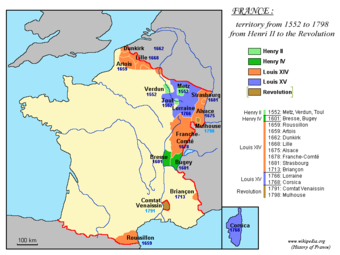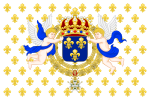Kingdom of France (987–1792)
|
Royaume de France Kingdom of France 987–1792 |
|||||
|
|||||
|
|||||
| Motto : Montjoye Saint Denis | |||||
| Official language | French (officially from 1539) | ||||
| Capital | Paris | ||||
| Form of government | Absolute monarchy (from September 3, 1791 constitutional monarchy ) | ||||
| Head of state |
King See list of rulers of France |
||||
| Head of government | prime minister | ||||
| currency | Livre | ||||
| National anthem | |||||
| founding | 843 | ||||
| resolution | September 21, 1792 | ||||
| map | |||||

|
|||||
The Kingdom of France or the Kingdom of the French was a kingdom in Western Europe. The term Kingdom of the Franks was in use until the 13th century , as the kingdom goes back to the West Franconian Kingdom founded in 843 . The latter, in turn, is based on the royal rights of the Franconian partial and total empires that existed under the roof of the Franconian Empire . The Franconian Empire has a forerunner in the Salfränkische Reich , which combined the Frankish individual empires at the end of the 5th century.
The French kingdom was ruled by two dynasties : the Carolingians (853–987) and the Capetian dynasty (987–1792). The latter is divided into the direct Capetians (987–1328), the House of Valois with branch lines (1328–1589) and the House of Bourbon with branch lines (1589–1792).
Designation of the state or the heads of state
In the Carolingian era up to the division of Verdun (751–843), the title King of the Franks continued. Charles I ( Charlemagne ) also assumed the title of Roman Emperor in 800, which his successors also took over. The sub-kingdoms continued to matter. The division of the empire in 843 saw, among other things, the West Franconian Kingdom, from which the Kingdom of France became. However, the West Franconian rulers retained the title of King of the Franks until the 13th century, and they continued to be elected. Charles II ( Karl the Bald ) was also a Roman emperor .
Even after the change of dynasty in the West Franconian Empire from the Carolingians to the Capetians in 987 - which historiography often saw as the beginning of French kingship next to 843 - the title King of the Franks (Roi des Francs) continued for a long time. Fellow kings secured the dynastic existence. Until the last French king in 1848 ( July Monarchy ) the kings of the Capetian dynasty, however (1814 / 1815-1848 direct Capetians 987-1328, Valois and secondary lines from 1328 to 1589, Bourbon and branch lines from 1589 to 1792,) came from, from different houses .
It was not until Philip II (1180–1223) first used the title King of France (Roi de France, Franciae Rex , more rarely Rex Franciae ) around 1190 . Louis IX (1214–1270) changed the official name from King of the Franks to King of France during his reign . The title King of the Franks remained in use until Philip IV (1268–1314). Francorum Rex can be found on coins until the 17th century.
The title King of France and Navarre (Roi de France et de Navarre) was valid from 1285 to 1328 and again from Henry IV's accession to the throne until 1789. Between 1328 and 1589, only King of France was used again. The addition of the Most Christian King came up under Charles VII . The constitution of September 3, 1791 made Louis XVI. to the King of the French (Roi des Francais) . He kept this title until the proclamation of the republic on September 21, 1792. Instead of the territory, reference was now made to the citizens.
Parallel to the name of the ruler, the expression Kingdom of France (Royaume de France) also came into use in the 13th century and replaced Royaume des Francs (Kingdom of the Franks) or Francie occidentalis (Western Franconia) . The constitution of September 3, 1791 made the absolute monarchy a constitutional one . An external sign of this was that the king now had to bear the title of King of the French .
Names of the heads of state:
- 10th century–12th / 13th centuries Century: King of the Franks (Rex Francorum)
- 12./13. Century – 1791: King of France and Navarre (Roi de France et de Navarre)
- 1791/92: King of the French (Roi des Français)
Designations of the state:
- 10-13 Century: Kingdom of the Franks (Royaume des Francs)
- 13th century – 1792: Kingdom of France (Royaume de France)
See also
literature
- Joachim Ehlers , Heribert Müller and Bernd Schneidmüller (eds.): The French kings of the Middle Ages. From Odo to Charles VIII. 888–1498. Beck, Munich 1996, ISBN 3-406-40446-4 .
- Joachim Ehlers: History of France in the Middle Ages. Kohlhammer, Stuttgart et al. 1987, ISBN 3-17-009801-2 (completely revised new edition. Primus, Darmstadt 2009, ISBN 978-3-89678-668-5 ).
- Peter Claus Hartmann : History of France. From the Middle Ages to the present (= Beck'sche Reihe. Vol. 2124). 5th, revised and updated edition. Beck, Munich 2015, ISBN 978-3-406-67330-6 .
Individual evidence
- ↑ Carlrichard Brühl : The birth of two peoples. Germans and French (9th-11th centuries). Böhlau Verlag, Cologne et al. 2001.
- ↑ Maurice Adrieux: . Henry IV of France good king. Societäts-Verlag, Frankfurt / Main, 1979.
- ^ French constitution of September 3, 1791. In: Verfassungs der Welt. Andreas Clement, accessed January 3, 2019 .


